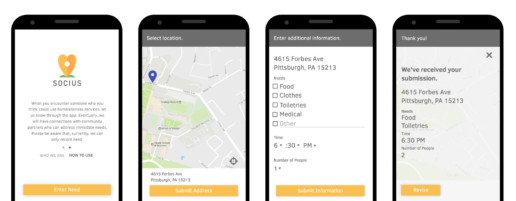How can technology better serve the needs of underserved populations throughout Pittsburgh? I worked with a small HCI research team to understand how location mapping and crowdsourcing could be utilized to better deliver services to Pittsburgh’s Homeless population. Research is still on going.
I served as the design researcher on a small team lead by Kyung Lee Min.

Homelessness is a devastating problem affecting over half a million people across the nation at any given time. A significant threat to wellbeing for those who are homeless, especially those who are chronically homeless, is accessing services. While some shelters may co-locate services such as medical, legal, social and food, others do not. Those who are homeless are then required to spend resources and time traveling between distributed services. Additionally, subsets of the population who are homeless may feel uncomfortable accessing these services as they exist for reasons ranging from discomfort at acknowledging their current homelessness to previous disrespectful treatment or harassment at the facilities. Several service providers have been experimenting with a model delivers services directly to the homeless community. However, little data exists on where the homeless population gathers or how members move across the city to use access services; most of these reach-out services function based on the information transmitted through word-of-mouth by service providers and the homeless population; and service providers acknowledge that there are homeless populations in the city that they are currently unaware of, especially those who recently become homeless, yet they do not know where they are and there is no method to communicate with them. In conjunction with a small research team, we spent the semester working with those within and without the homeless community to develop and understand the implications of a crowdsourcing service to better understand the locations of the homeless population throughout Pittsburgh.